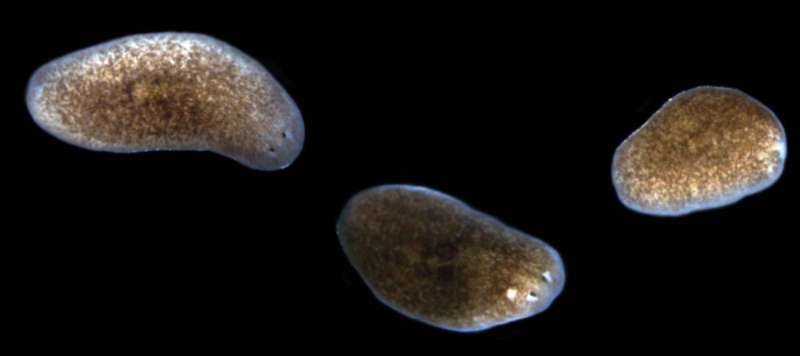Shifts in the microbiome impact tissue repair and regeneration

Researchers at the Stowers Institute have established a definitive link between the makeup of the microbiome, the host immune response, and an organism's ability to heal itself.
They showed that a dramatic shift in the microbial community of planaria robs the freshwater flatworm of its superior regenerative abilities. This same shift has been observed in human inflammatory disorders, though previous attempts to mimic it in lower organisms like fruit flies or zebrafish have proved unsuccessful.
The study, published in the journal eLife, provides a valuable model for uncovering the basic molecular mechanisms governing the interplay of immunity and regeneration, and could point the way toward new therapies to combat serious human ailments like chronic non-healing wounds.
"This is the first animal model to link pathological shifts in endogenous bacteria with the inhibition of regeneration," says Alejandro Sánchez Alvarado, Ph.D., an investigator at the Stowers Institute and the Howard Hughes Medical Institute, and senior author of the study. "We know that some kinds of bacteria are critical to our health, and that other kinds of bacteria can make it very difficult for us to recover from illness. Now we can study how the changing nature of the microbiome - and the way the immune system responds to those changes - impacts the natural execution of regenerative processes."
For a long time, researchers believed that the immune response primarily posed a barrier to effective tissue regeneration and repair. However, recent studies in a variety of different organisms have shown that it can play a central role in promoting this process as well. Still, the molecular mechanisms driving these diametrically opposed outcomes remain unclear.
A sudden dilemma in the Sánchez Alvarado Laboratory presented an opportunity to dissect the perplexing duality of the immune system. An infection struck part of the lab's planaria population. The infected animals developed lesions around their eyes, and those lesions grew larger and larger until their entire head degenerated. Normally, the worms could simply regrow a new head, but the infection somehow thwarted their regenerative powers.
Sánchez Alvarado's team and the Stowers aquatics facility developed a modified tank system that was capable of circulating and sanitizing the culture media so they could rear healthy worms, but they found that when they took the worms out of that system, they quickly got sick again. Although most of the lab members viewed this development with frustration, Chris Arnold, Ph.D., a new postdoctoral research associate at the time, took a different perspective.
"I saw this as the perfect inducible model system. It was making lemonade out of lemons," Arnold said. "We could take worms that were healthy, remove them from the tank system when desired, and place them in other conditions where they would then become ill. Amazingly, we found that when we withdrew the worms from the tank system and they developed problems, we could successfully treat their tissue degeneration with antibiotics. That suggested bacteria might be involved."
Arnold decided to determine what kind of bacteria were living with the worms. He conducted a bacterial census and found that the microbiome of the worms was surprisingly similar to that of humans. When the worms were healthy, they housed a large population of Bacteroides - a group of helpful, supportive, symbiotic bacteria - and a smaller population of Proteobacteria - a group that contains a number of dangerous human pathogens. But when the worms developed lesions, they experienced a huge surge in Proteobacteria, some members of which have been shown to cause peptic ulcers and stomach cancer in humans.
The researchers wondered if it was not the bacteria itself, but rather the immune system's response to the bacteria that was impairing the worm's ability to regenerate. To test this hypothesis, Arnold used an advanced molecular technique called RNA interference to silence core components of the immune system. Then, he looked to see how each one affected the ability of the worms to repair their lesions and regenerate their heads during infection.
The researchers discovered that when they blocked a gene called TAK1 kinase, the worms were able to recover from the damage incurred from infection. They looked at other genes that interacted with TAK1 kinase including activators and inhibitors of the TAK1 pathway and found that most of them also affected regeneration, but only when worms were infected.
"Our findings suggest that there is something special about regeneration during infection that's different than normal regeneration. There are genes that prompt degeneration in one case, and regeneration in another. It is topsy-turvy, completely different from what we would expect. We think this pathway might act to get rid of infected cells, clearing them out so the infection cannot spread to healthy tissue. Only when we block the pathway, can we allow regeneration to occur even in the presence of infection," said Sánchez Alvarado.
Sánchez Alvarado says that in the future, it may be possible to develop small molecules that suppress this immune pathway in order to bump up tissue repair and regeneration not just in a simple organism like planaria, but also in higher organisms like humans. However, first they will need to understand more about the activators and inhibitors in the pathway, and how they interact.
"Our healthcare system is struggling to deal with conditions of impaired wound healing. We know that bacteria are impediments to healing in patients, and that antibiotics aren't always effective, especially with the rise of antibiotic-resistant bacteria. By understanding the genes and pathways involved in the immune response, we may be able to interpret the signals that determine whether an organism decides it is beyond repair or tries to regenerate. Perhaps then could we develop more effective therapies," said Arnold.
Journal information: eLife
Provided by Stowers Institute for Medical Research



















